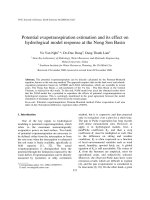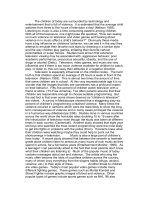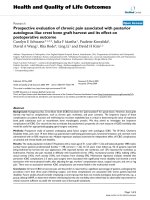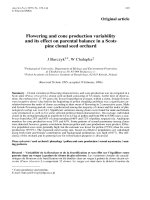Social media research and its effect on our society
Bạn đang xem bản rút gọn của tài liệu. Xem và tải ngay bản đầy đủ của tài liệu tại đây (520.68 KB, 5 trang )
World Academy of Science, Engineering and Technology
International Journal of Social, Behavioral, Educational, Economic, Business and Industrial Engineering Vol:8, No:6, 2014
Social Media Research and Its Effect on Our Society
A.T.M Shahjahan, Kutub Uddin Chisty
III. METHODOLOGY
International Science Index, Humanities and Social Sciences Vol:8, No:6, 2014 waset.org/Publication/9998891
Abstract—Social media refers to the means of interactions
among people in which they create share, exchange and comment
contents among themselves in virtual communities and networks.
Social media or "social networking" has almost become part of our
daily lives and being tossed around over the past few years. It is like
any other media such as newspaper, radio and television but it is far
more than just about sharing information and ideas. Social
networking tools like Twitter, Facebook, Flickr and Blogs have
facilitated creation and exchange of ideas so quickly and widely than
the conventional media. This paper shows the choices,
communication, feeling comfort, time saving and effects of social
media among the people.
At first select the topic base on objectives. A vast literature
review has been done to determine the analytical output. A
questioner is prepared for field survey data collection. SPSS
data output has been shown the required results.
IV. SAMPLE SIZE DETERMINATION
Total numbers of students have been used for the
determination of sample size. The initial sample size was
determined by the following formula [1]:
n=
Keywords—Media, Choice, Effect.
I. INTRODUCTION
I
N the past five years, social media websites have become
ubiquitous, giving young people a new way to interact with
each other and communicate with the world. This new form of
communication depends on user created content, not mass
produced messages coming from large media companies. But
as with other media before it, social media's rise to
prominence has experienced some very serious growing pains.
Companies like Facebook, MySpace, and Twitter have
struggled to balance an inviting interactive environment with
the ultimate pursuit of profit. This issue of the paper aims to
explore some of the issues related to social media, and a
generation fully engaged in this interactive world. The main
focus is popular social media sites such as Facebook,
MySpace, Twitter, Wikipedia, YouTube, and LinkedIn, but
other social networking sites are explored as well.in this paper
there 67 sample size has been distributed among the three
universities named Govt. Bangla college, America Bangladesh
University and Pangsha university college in Dhaka city. It
offered suggestions, guidance, communication media choice,
influences factors, some opinion about social media choice.
A. Objective
The aim is to discuss about the interactive environment of
social media, media choice and effects.
II. STUDY AREA
67 sample sizes have been distributed among the three
universities named Govt. Bangla College, America
Bangladesh University and Pangsha University College in
Dhaka City.
A.T.M Shahjahan is Faculty Member of Department of Urban & Regional
Planning of Chittagong University of Engineering & Technology, Bangladesh
(Phone: +8801711943126; e-mail: ).
Kutub Uddin Chisty is the student of the Department of Urban & Regional
Planning of Chittagong University of Engineering & Technology, Bangladesh
(e-mail: chisty_cuet10@ yahoo.com).
International Scholarly and Scientific Research & Innovation 8(6) 2014
z 2 pq
d2
where, Z is the normal variety and which has 1.65 for 90%
confidence interval; p is the target proportion. In this case, we
have assumed p= 0.5; p+q =1, therefore q=0.5; and d is the
desired error which is 0.1.
The initial sample size is therefore:
n0 =
(1.65) 2 × 0.5 × 0.5
= 68.0625
(0.1)
These sample size was adjusted by using the following
formula:
n=
n0
= 67.87 ≅ 68
n0
N
1+
where n is requiring sample size and N is Total numbers of
students is about 32371(apex.). The sample size has been
distributed among the three universities named Govt. Bangla
College, America Bangladesh University and Pangsha
University College in Dhaka city.
V. ANALYSIS
A. Social Media Choice
The oldest and most powerful form of mass media is the
word, both written and spoken; from catholic priests to
traveling storytellers, the word has held credibility [5]. A new
platform, social media, has taken the power of the word to
new levels, transforming companies, society communication.
Platforms such as Twitter and Facebook are conduits for
dialogues between many to many, held in a very visible
format. This new format is altering the methods of advertising,
merging both the advertiser and the advertised. If a company
hopes to succeed in this new generation of technology they
must embrace social media. Social networking sites are small
virtual villages. Different people use different communication
2009
scholar.waset.org/1999.10/9998891
World Academy of Science, Engineering and Technology
International Journal of Social, Behavioral, Educational, Economic, Business and Industrial Engineering Vol:8, No:6, 2014
International Science Index, Humanities and Social Sciences Vol:8, No:6, 2014 waset.org/Publication/9998891
sittes like Sociaal networkingg sites (face book,
b
twitter,, MSN,
Skkype, Google talk), Voice ccalling (telephhone, cell phoone and
inntercom), throuugh writing (eemail, letter and
a fax), Face to face
coommunicationn (meeting). A figure has been
b
show thaat most
off the people usse now face book, twitter, MSN,
M
Skype, Google
taalk.
phhone daily, YoouTube use weeekly and emaail monthly (F
Fig. 3).
F 1 Communnication media choice
Fig.
B. Communiccation Media Using Schedu
ule
Communicattion is the esssential elemeent that creattes and
m
maintains
relattionships. In this
t
day and age; communnication
technology has developed to become bothh simple and fast.
f
For
exxample, we no
n longer neeed to look up
u old classm
mates in
phhone directoriies anymore in
i order to finnd out what they’ve
beeen doing. Innstead, we usee social media networks such
s
as
Faacebook and MySpace
M
in oorder to keep ourselves
o
upddated on
ouur family andd friends’ livess no matter where
w
they aree in the
w
world.
Accordiing to statistiics, Facebookk has more thhan 400
m
million
active users, and about 50% of them log on to
Faacebook at anny given day (Fig. 2). Peoople also spennd more
thhan 55 minutess on Facebookk using daily.
mmunication m
media using scheedule comparess
Fig. 3 Com
C. Communiccation Media P
Preferences
Our question
naries’ surveyy data analyssis show thatt about
15% people higghly like comm
munication media
m
and abouut 60%
people like meddia because off its beefiness (Fig. 4).
Figg. 4 Communicaation media preferences
D. Social Meddia Feeling Coomfort and Tim
me Saving
Our question
naries’ surveyy data analyssis show thatt about
mfort on Sociial networkinng sites
488% people aree feeling com
t
and abouut 53%
(Faacebook, twittter, MSN, Skkype, Google talk)
people thinkingg Voice calliing (telephonne, cell phonne and
m
saving media
inttercom) is perrfect for timee as well as money
(Fiig. 5).
Fig. 2 Communicattion media using schedule
Again, most of the peoplee use at a higghest percentaage cell
International Scholarly and Scientific Research & Innovation 8(6) 2014
2010
scholar.waset.org/1999.10/9998891
World Academy of Science, Engineering and Technology
International Journal of Social, Behavioral, Educational, Economic, Business and Industrial Engineering Vol:8, No:6, 2014
International Science Index, Humanities and Social Sciences Vol:8, No:6, 2014 waset.org/Publication/9998891
vissionaries amo
ong us, who, in creating
g social netw
working
plaatforms, have helped write some of the present occurrrences
being experiencced in the worlld today.
Fiig. 7 Facebook,, Twitter, and G
Google+ - A diffferent world off social
netw
working
Fig. 5 Social media feeeling comfort an
nd time saving
E. Social Med
dia Securenesss and Flexibiility
Survey dataa analysis sho
ows that abo
out more thaan 50%
peeople are feelling secure inn face to face communicatiion and
m
more
than 40% people flexib
ble on voice caalling media.
With Faceboo
ok, Twitter, G
Google+ and other
o
social neetworks
wee have becomee much awaree of the world we are living
g in and
thiis is one of the changges being tallked about. Social
Neetworking giaants like Facebbook, Twitterr, and Google+
+ have
contributed to create a wholee new world where
w
free to express
e
ouur opinion and
d share it with friends and peers
p
[3]. Thiss world
off social media gives scope to everyone to
t express and
d share
t be the partt of it.
ideeas, thoughts and feelings, who want to
W
Within
the passt ten years, social mediia such as Twitter,
T
Faacebook, MyS
Space, YouTubbe, Flickr, and
d others have grown
at a tremendou
us rate, enlistting an astron
nomical num
mber of
useers. Social meedia have inevvitably becom
me an integral part of
thee contemporrary classroom, of advertising and public
rellations industrries, of politiccal campaignin
ng, and of num
merous
oth
her aspects off our daily existence [4]. Alll chapters con
nstitute
oriiginal researcch while usingg varied reseearch methodo
ologies
forr analyzing an
nd presentingg information about social media.
So
ocial Media: Usage
U
and Im
mpact is a trem
mendous sourrce for
ed
ducators, practtitioners (suchh as those in ad
dvertising, P.R
R., and
meedia industriies), and liibrarians, am
mong others. This
collection is an
n essential ressource for any
y media techn
nology
course. With th
he rapid prolliferation and adoption off social
uggernaut thatt must be add
dressed in the higher
meedia, it is a ju
ed
ducation curricculum and reseearch [5].
VI. FINDINGS
d flexibility
Fig. 6 Social media secureness and
F. Social Med
dia in Our Mo
odern Civiliza
ation
Social mediaa has become this significan
nt part of our modern
m
ciivilization. It is a defining trait of how integrated ourr social
in
nteractions hav
ve become. We
W credit thiss achievementt to the
deevelopments that
t have madee in technolog
gy to ingenuity
y of the
International Scholarly and Scientific Research & Innovation 8(6) 2014
A. The Effectss of Social Meedia on Teenag
gers
Children todaay are as techhnologically connected
c
as anyone
a
onn the planet haas ever been. T
They have access to social media
lik
ke Facebook, Integral and Twitter and they
t
can be able
a
to
ch
hat in real tim
me with their ffriends who are
a a thousand
d miles
aw
way. Various reports
r
suggest that about eighty-three percent
p
off American yo
outh use their phones for em
mail, mobile in
nternet
an
nd texting. Thee report furtheer states that th
hese American
n teens
sen
nd and receiv
ve text messaages 144 timees a day [2]. If the
teeens are not teexting, they aare usually on
n social netw
working
sittes like Facebook and Twittter where they chat, share photos
2011
scholar.waset.org/1999.10/9998891
World Academy of Science, Engineering and Technology
International Journal of Social, Behavioral, Educational, Economic, Business and Industrial Engineering Vol:8, No:6, 2014
International Science Index, Humanities and Social Sciences Vol:8, No:6, 2014 waset.org/Publication/9998891
and video and participate in gaming. The negative effects of
being this “plugged in” are beginning to take enormous effect
on kids. Because social interaction comes overwhelmingly
online rather than face to face, American youth are showing
severe lack of social skills. They are often more comfortable
with technology than they are with talking to people. They
have not learned the proper communication and conversation
skills, how to deal with interpersonal situations and how to
date and get to know other people behind the screen.
Researchers have found that the middle-school, high school
and college students who used Facebook at least once during a
15 minute period get lower grades overall [3].
B. Reasons for Negative Effects of Media on Teens
Many teens usually spend sleepless nights on social media
without the knowledge of their parents. The disruption of
sleep has had adverse effects on the teens. It has led to cases
of insomnia, mood swings, attention deficits at school and
increased obesity just to mention a few. These are some of the
serious negative effects of social media on teenagers and
issues that are arising with kids often addicted to Facebook.
With such overwhelming evidence of the negative effects of
social media on our children, why then, are many parents not
taking more action to protect their children?
There perhaps are three major reasons:
1) Parents are unaware of the issues involved in the online
connections. While kids are plugged in to social media,
only about 40% of parents are involved themselves [4].
Parents may not be aware of their children’s “pages” and
don’t fully understand privacy policies and they don’t
realize what kinds of public postings are taking place,
involving their children.
2) Parents don’t want to interfere in their children’s social
lives. Most parents want their children to be popular,
accepted and enjoy a happy social life. Parents sometimes
concern themselves with children’s “rights” – their right
to privacy and their right to interact in today’s popular
forums [5]. Parents want to allow their children to be as
connected as the other kids they associate with, and so
they tell themselves that everything is ok.
3) Parents are afraid to take a stand. Many of “modern”
parents are becoming apathetic to the real dangers that too
much social media can present to their children [4]. They
don’t want to push their teens away and so they allow
their participation in social media to go unchecked rather
than make a “big deal” out of it [2].
The problems this new online society creates are not going
away and will continue to grow. Parents must get off the
sidelines and get involved! Parents have the responsibility to
protect their children and be aware of what is going on in the
online world. Investigate and help your child adjust privacy
settings. Be aware of who can see what they post, and what is
being posted about them. Take with them about online safety.
Make sure your teens have plenty of offline time as well.
Restrict the times and frequency of online interaction.
Place all phones in the docking station at night where they
are required to stay until everyone leaves for work and school
International Scholarly and Scientific Research & Innovation 8(6) 2014
in the morning. Consider allowing siblings to share a phone
they can “check out” from mom or dad.
Create family-determined “unplugged” hours when children
can participate in other activities such as outdoor games,
reading, talking, playing together etc. [3].
Social media has a tremendous effect on us today, but with
parental participation and kids’ cooperation, the effects can be
positive for everyone.
VII. CONCLUSION
A. Positives Effects
Meeting people you may not have met outside the social
media forums
2. Sharing ideas beyond the geographical boundaries-like
am doing now.
3. Reducing travelling costs, costs of buying books and other
references especially if you need a page or two in the
whole book and other costs
4. Expansion of democratic space. With some governments
imposing serious mass media ban, social media can offer
some outlet
5. You can persuade your pals to maintain peace in your
society through the social media
6. If you combine social media and other media, you can
reach more people for purposes of business, education,
health etc.
1.
B. Negatives Effects
Social media can be abused by its users too. It’s not fair for
people to discuss anyone on social media platforms without
consent. Then there is personification [5]. You may not know
whether the image i use is my real one this may encourage the
society to be falsely. Social ties like family ones can also
weaken as people spend more time connecting to new people.
As long as the basic human need to connect is met online,
offline friends may not be regarded.
ACKNOWLEDGMENT
At first all praises belong to Almighty Allah then we
express our profound gratitude and Indebtedness to our friends
and classmates Mohd. Mostakim and Al-kauser, students of
Department of Urban and Regional Planning (URP),
Chittagong University of Engineering and Technology for
their cordial encouragement, constant guidance, inspiration
and valuable suggestion to prepare this paper.
REFERENCES
[1]
[2]
[3]
[4]
2012
Hasan, MR (2010), ‘land use and land value in urban fringe area of
khulna, bangladesh’, MURP thesis, Bangladesh University of
Engineering and Technology, Dhaka, Bangladesh
Housley, Sharon. “RSS Feeds and Copyright Law.” World Law Direct.
3 May 2010. Web. 3331/rssfeeds-copyright-law.html
J. J. Burns. And D. R. Anderson, “Attentional Inertia and Recognition
Memory in Adult Television Viewing,” Communication Research 20
(1993): 777–99.
Matyszczyk, Chris. "Facebook Entry Gets Office Worker Fired."
Technically Incorrect 26 Feb. 2009: n. pag. Web. 17 May 2013.
< 8301-17852_3-10172931-71.html>.
scholar.waset.org/1999.10/9998891
World Academy of Science, Engineering and Technology
International Journal of Social, Behavioral, Educational, Economic, Business and Industrial Engineering Vol:8, No:6, 2014
R. D. Hess and L. J. McGarvey, “School-Relevant Effects of
Educational Uses of Microcomputers in Kindergarten Classrooms and
Homes,” Journal of Educational Computing Research 3 (1987): 269–87.
International Science Index, Humanities and Social Sciences Vol:8, No:6, 2014 waset.org/Publication/9998891
[5]
International Scholarly and Scientific Research & Innovation 8(6) 2014
2013
scholar.waset.org/1999.10/9998891









